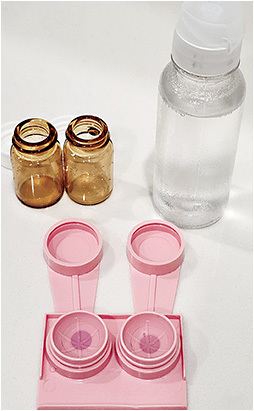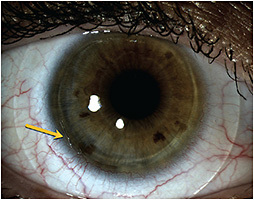
SOMETIMES CHANGE is difficult. For established hybrid contacts lens wearers who are switching out to a new, replacement pair of lenses, they may complain of discomfort with initial application of their new specialty contacts. Here are four tips to ensure a smooth transition for these patients.
- Reinforce replacement cycle. Hybrid lens manufacturers recommend a six-month replacement schedule (synergeyes.com/patient-information ). For some patients who are heavy protein depositors or who suffer from poor surface wetting of the lens surface, quarterly replacement may be appropriate.When the same lens pair is overworn, this can result in lens and/or corneal warpage, which can contribute to discomfort during the transition phase. This can also result in changes to visual acuity, especially post-lens wear when patient puts on their habitual spectacle lenses. This can falsely warrant a new spectacle refraction and a corresponding unnecessary change in hybrid lens power.
- Confirm hybrid lens parameters. Unless otherwise specified, the hybrid lens lab will automatically charge you for the recommended biannual replacement. When you buy four lenses, it is more cost-effective than buying two lenses alone.The second lens pair that fulfills the annual supply may be on automatic shipment. If you made modifications to the lens design, ensure you have the final design confirmed with the lab. For example, a 49-year-old multifocal hybrid lens wearer’s finalized fit consisted of her most recently ordered right lens and the initially ordered left lens. If the lab is not notified of your finalization, they will send the last ordered pair.
- Presoak lenses prior to lens pick up. When hybrid lenses are shipped, they arrive hydrated in glass vials; however, they can become adhered to the bottom of the vial, causing kinks to the skirt. Shake the vial to release any possible adhesion and transfer to a flat pack with fresh multipurpose solution (Figure 1). This will help to ensure comfortable wear during first lens application of the replacement pair.

Figure 1. Shake lenses to remove from transport vials and transfer to a new lens case with fresh multipurpose solution prior to dispensing a new lens pair. - Troubleshoot clinically insignificant bubbles. When new, replacement hybrid lenses are placed on eye, they may cause small air bubbles at the junction between the GP center and soft skirt (Figure 2). These typically do not warrant a fit modification; however, they can contribute to discomfort with initial wear. Patients can remedy this phenomenon by placing a drop of non-preserved artificial tear inside the bowl of each lens prior to application.

Figure 2. Bubbles found at the junction of the GP center and soft skirt of a newly dispensed hybrid lens. These typically do not warrant a modification to lens fit.
Hybrid lens wearers should be monitored every six to 12 months to ensure adequate corneal health, appropriate lens performance, and compliance with lens wear. Providing them with the tips above can help to educate on why a slight adaption might be needed when their new replacement hybrid lenses are dispensed. CLS



